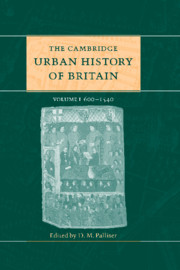Book contents
- Frontmatter
- Part I Introductory
- Part II The early middle ages 600–1300
- 3 General survey 600–1300
- 4 Power and authority 600–1300
- 5 Society and population 600–1300
- 6 The economy of British towns 600–1300
- 7 Churches, education and literacy in towns 600–1300
- 8 The topography of towns 600–1300
- 9 London from the post-Roman period to 1300
- 10 The large towns 600–1300
- 11 Small towns 600–1270
- Part III The later middle ages 1300–1540
- Part IV Regional surveys
- Part V Conclusion
- Appendix: Ranking lists of English medieval towns
- Select bibliography
- Index
- References
11 - Small towns 600–1270
from Part II - The early middle ages 600–1300
Published online by Cambridge University Press: 28 March 2008
- Frontmatter
- Part I Introductory
- Part II The early middle ages 600–1300
- 3 General survey 600–1300
- 4 Power and authority 600–1300
- 5 Society and population 600–1300
- 6 The economy of British towns 600–1300
- 7 Churches, education and literacy in towns 600–1300
- 8 The topography of towns 600–1300
- 9 London from the post-Roman period to 1300
- 10 The large towns 600–1300
- 11 Small towns 600–1270
- Part III The later middle ages 1300–1540
- Part IV Regional surveys
- Part V Conclusion
- Appendix: Ranking lists of English medieval towns
- Select bibliography
- Index
- References
Summary
In part III of this volume, towns are considered ‘small’ if they had populations of fewer than 2,000. For the early middle ages such a clear-cut division by size is both impossible and inappropriate – not merely for lack of data. During the ninth to twelfth centuries the urbanising potentials of a variety of places were gradually being realised in a range of different ways, and urban characteristics remained fluid. In 1200 Oxford and Cookham were very different sorts of places; in 800 they may have been quite similar. To apply a cut-off line across the whole period would be nonsensical, though the point comes when certain sorts of town (notably the planned and fortified towns in the tenth century) rise above the line and come within the scope of the previous chapter rather than this one. It seems more useful here to concentrate on processes than on size categories, and to treat the earlier and more modest stages of the urbanisation process as a continuum across these centuries.
Commercial activity is often considered a basic characteristic of urbanism, and it remains true that a place completely lacking a market is hard to define as even a small town. On the other hand, it has come to be realised that much marketing activity in early and high medieval Britain took place in pre-urban or entirely non-urban contexts. Sceatta distributions show that by 750, in southern and eastern Britain, exchange was taking place on open-ground sites and places of assembly such as deserted hill-forts; informal trading-places are now known to have remained numerous and important through the middle ages.
- Type
- Chapter
- Information
- The Cambridge Urban History of Britain , pp. 245 - 270Publisher: Cambridge University PressPrint publication year: 2000
References
- 3
- Cited by



